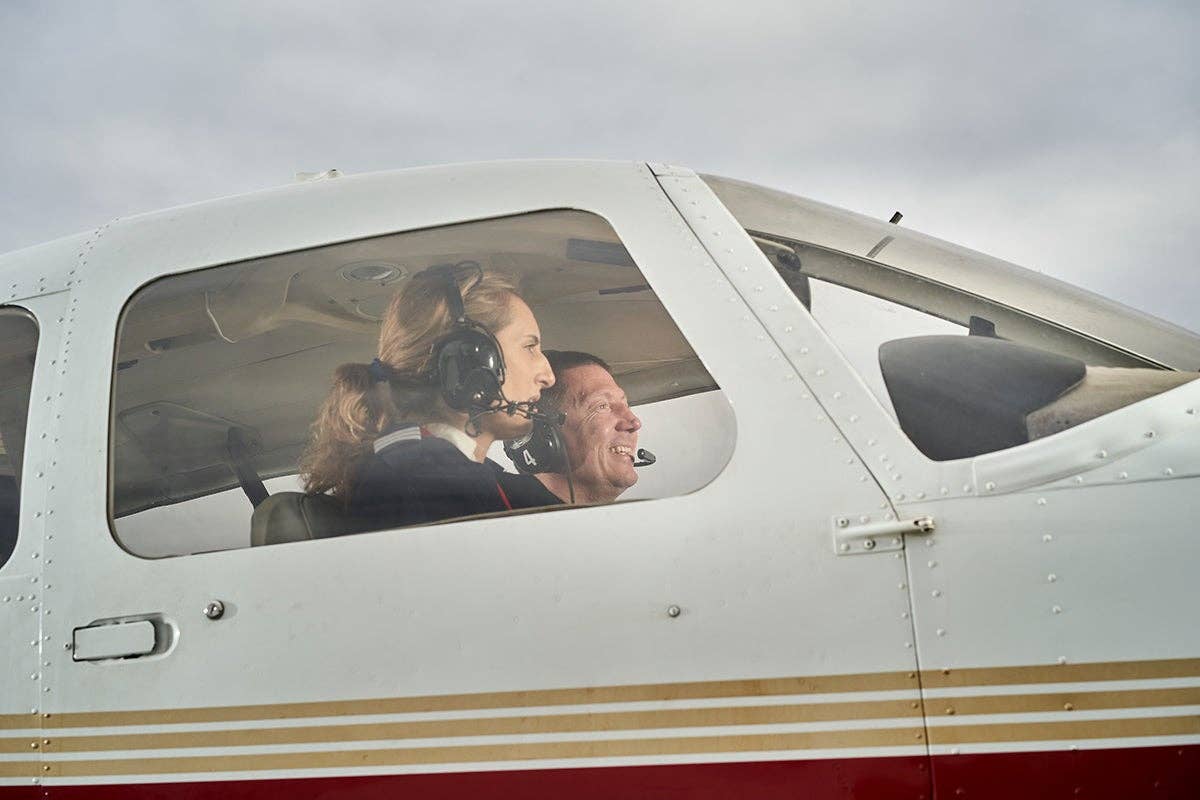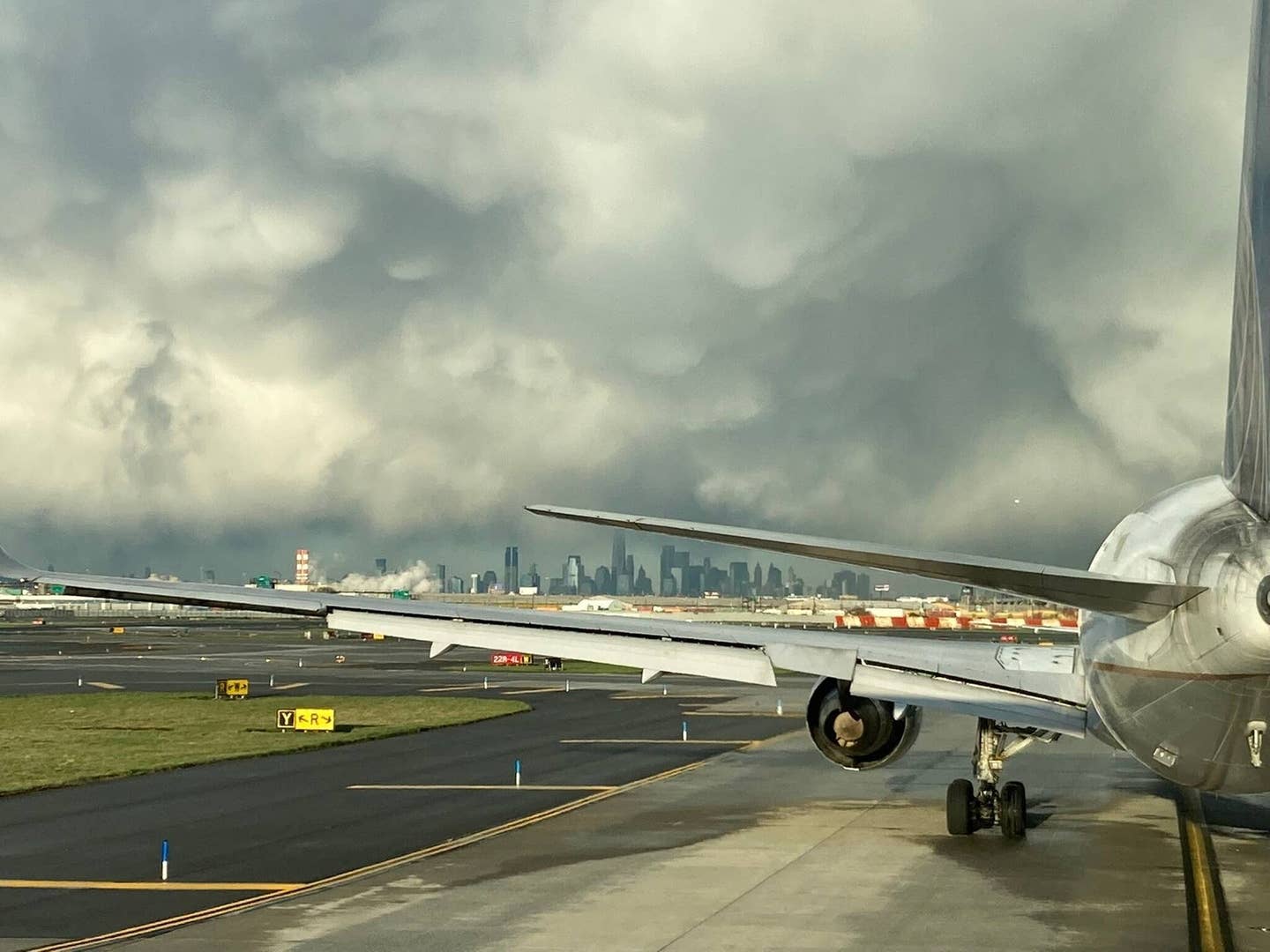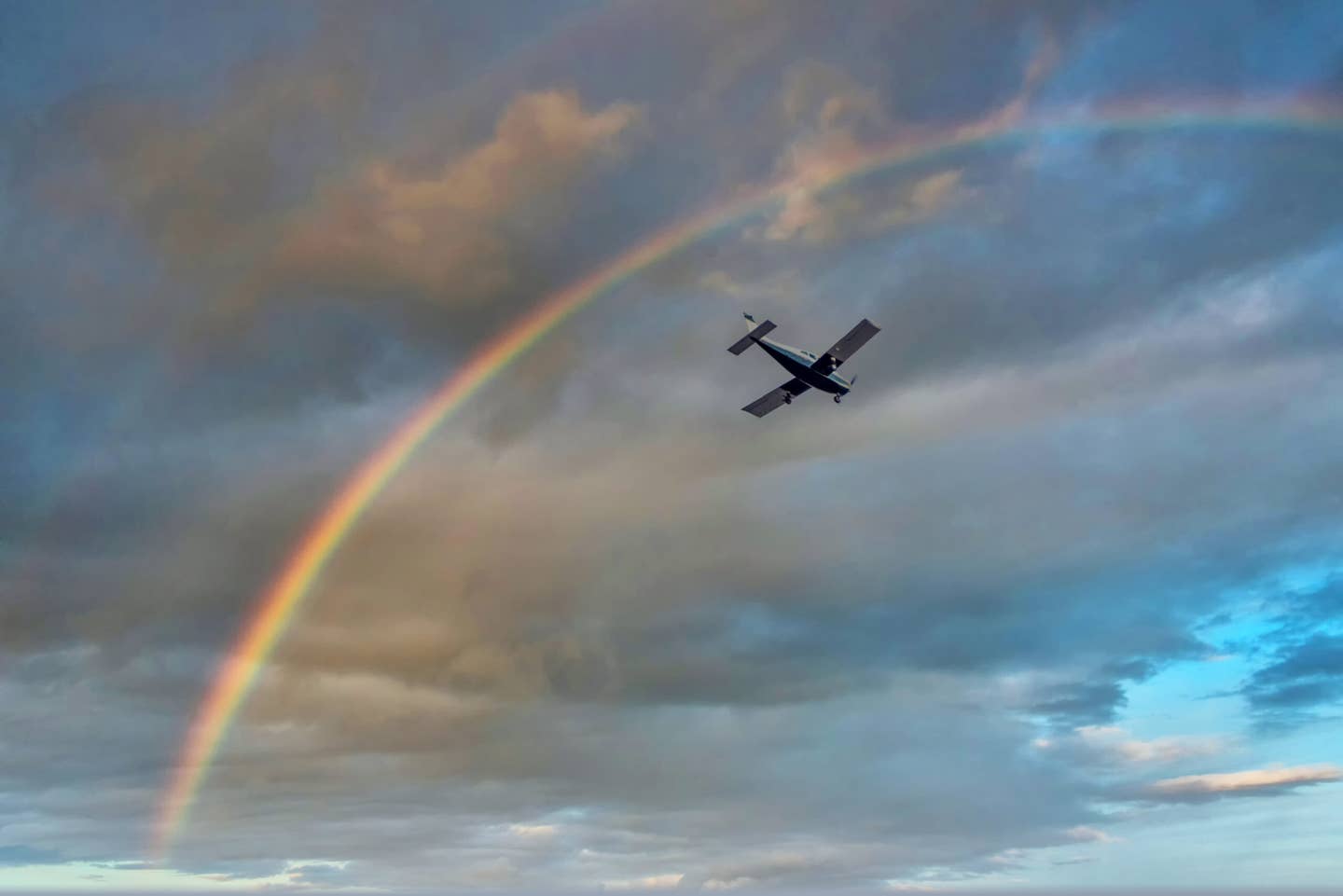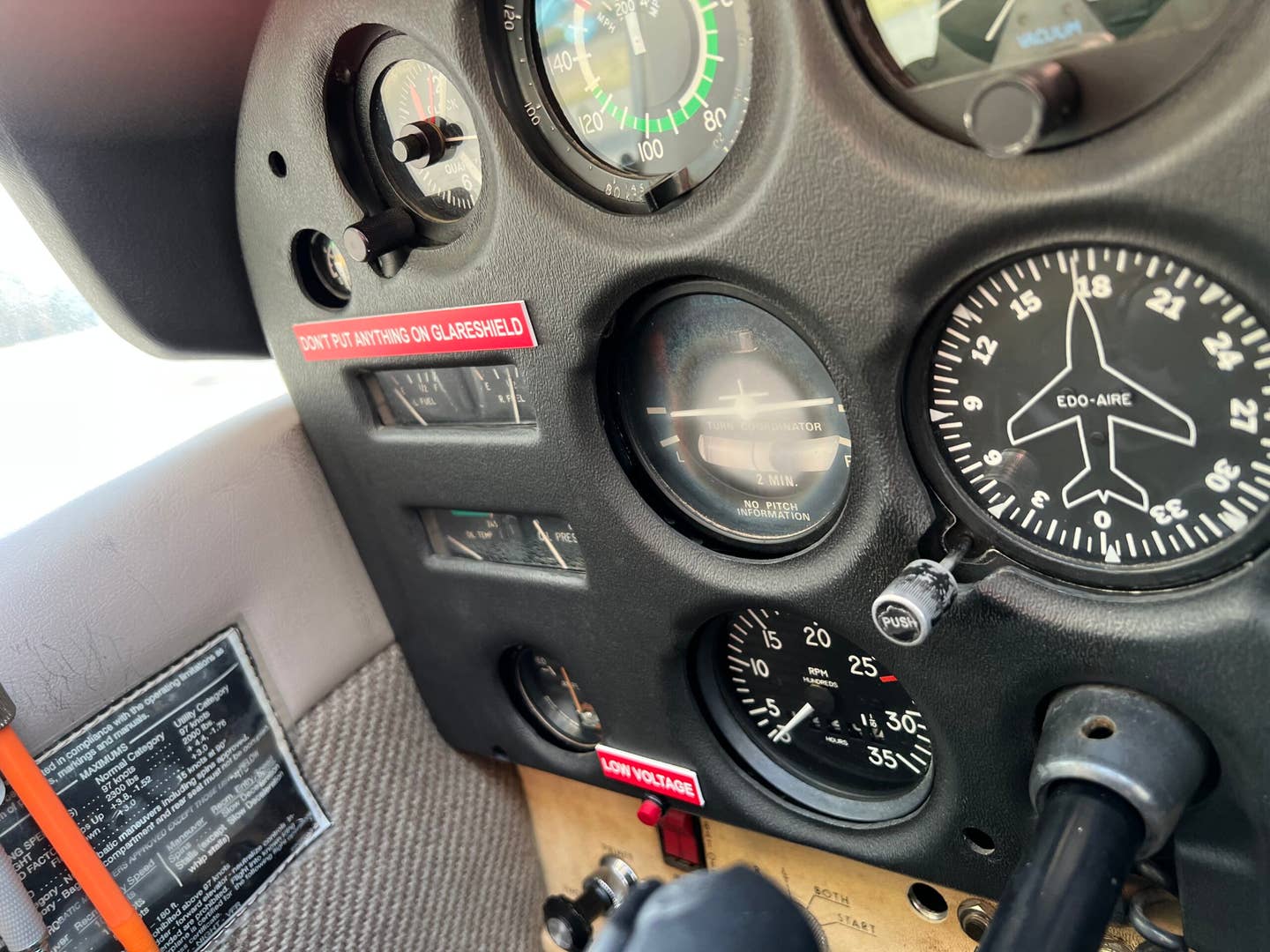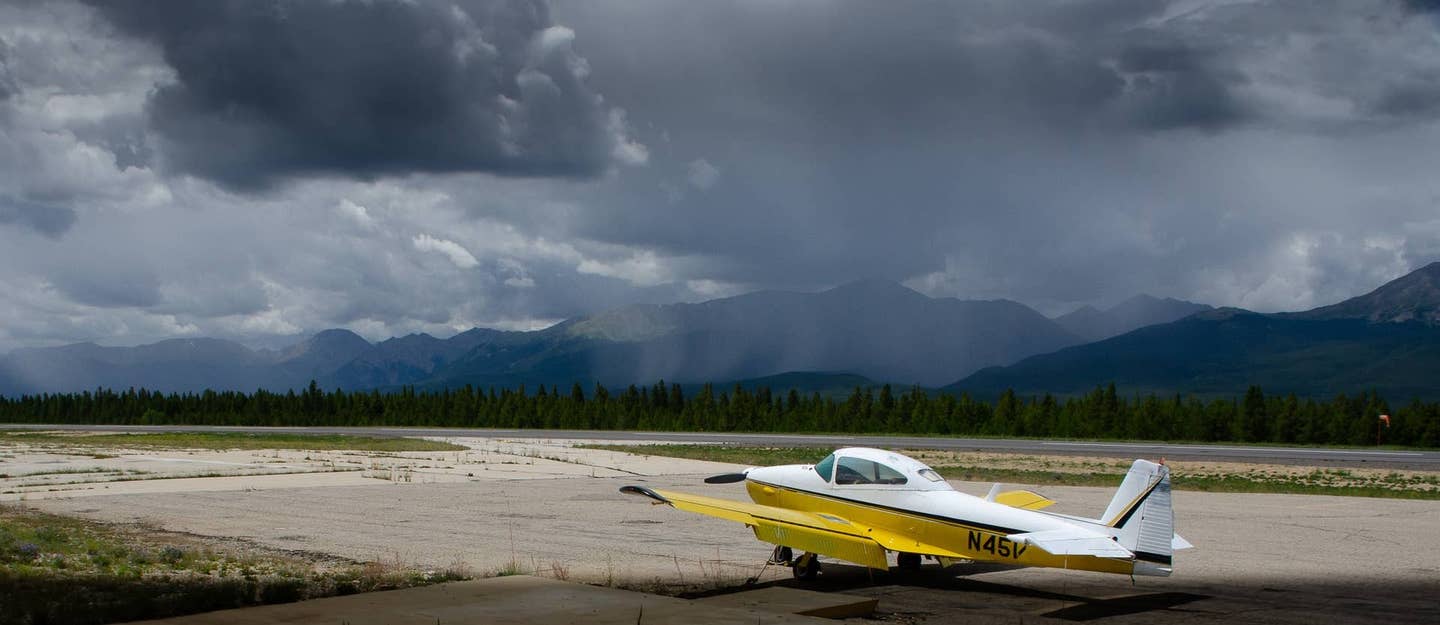
** From left: Martha, Jeff Crabtree and Jimmie
G. Crain during Wings Weekend.**
(May 2011) DID WE ACTUALLY MAKE a better pilot out of anybody, save any lives or keep any bent airplanes from littering the landscape? Who knows, but we sure had a good time putting on Wings Weekend at Hogan Field or, more properly, Butler County Regional Airport in Hamilton, Ohio. It started with me (and a chalkboard) on a Saturday morning at Blue Ash Airport, trading CFI renewals for donations of dual instruction, and it morphed into an annual 2½-day event with 70 to 80 instructors and up to 200 pilots earning their "wings." For the next 13 years any pilot could "just show up" at the airport for one day on the last weekend in June to get the required three hours of dual flight instruction and attend the required safety seminar. Thus, he earned one of the 20 phases in FAA's Pilot Proficiency Program and went home with a fancy certificate, pseudomilitary wings with stars, banners and phony gemstones and a genuine 61.56 flight review sign-off.
The idea of offering dual flight instruction and a seminar for free and all in one day wasn’t original. I’d heard about something like it in Kentucky, so I flew the 180 over to Owensboro on a covert spy mission. Sure enough, a chaotic mob of pilots and instructors were milling around, the CFIs holding up homemade signs advertising themselves (for free) and their airplanes (for rent). We could do this better by pairing up the pilots and CFIs in advance and giving the dual in two out-and-back sessions. And we’d have a bunch of rental airplanes available from local FBOs.
Putting this wildly ambitious scheme into motion without help was a colossal nightmare; at least 80 percent of people with “firm” reservations changed their plans in the 24 hours preceding the event. My low-tech system — humongous sheets of poster board and magic markers — was woefully inadequate, but somehow it worked.
Enter Jimmie G. Crain on a white charger, and we moved to Hamilton, where Jim was on the airport board and where Clippard Instrument put its big, new hangar at our disposal. A retired Air National Guard F-100 driver, Jim was an executive at Clippard, ran its flight department and was genuinely devoted to aviation safety. He was full of fun and enthusiasm but also brought a cool head, common sense and self-discipline — qualities way down at the bottom of my bag of tricks.
The other player was Jeff Crabtree, whom I met when he was managing the Aero Club at Wright-Patterson Air Force Base. Jeff’s sense of humor and his opinion of bureaucracies meshed with mine — nothing was sacred, which, of course, explained why he was running his own automotive supply business instead of working for the Air Force and why I was and would remain a lowly safety program person. Jim and Jeff were skeptical about my “just show up and we’ll pair you with a CFI” plan, convinced it spelled chaos at best and major rioting if things got ugly. But somehow, magically, with a microphone and a bank of blackboards, we matched pilots and instructors who didn’t know each other and sent them off for a briefing session and three hours of dual. I strongly believed the “not knowing each other” part was key to an effective program.
“Mr. Foster, you’ll be flying with Bob McConnaughey. Yeah, I know you planned on flying with Skid Slipmore again, but hey, say hi to Bob here and go fly. You’ll love it.”
“Skid,” of course, was the reason this guy couldn’t handle a crosswind over 5 knots or keep the ball anywhere near the center in a climb.
Hands down the biggest challenge wasn’t accommodating everybody, making last-minute changes, attracting instructors or volunteers, wheedling seed money from sponsors or rounding up rental airplanes. The challenge was ...
FINDING A SPEAKER
See, for whatever reason, there absolutely, positively had to be a banquet on Saturday night in the Clippard hangar. That meant we were always on the lookout for a banquet speaker with a recognizable name whom we could afford. Since we fed the CFIs and volunteers for free, there had to be a decent crowd of paying customers to break even, and nobody would come back to the airport after a sweaty, hard day of flying to listen to some FAA type pontificate on safety and regulations. Rod Machado, Bob Hoover and the Kings were way over our budget, so it had to be a nonprofit kind of guy or somebody selling his new book, an airplane or membership in an organization.
One year Jeff snagged the iconic and charming Bill Kirschner, who was in Dayton for something going on at Wright-Patterson. And the year Phil Boyer came, I put out a flier advertising it as an AOPA town meeting, not realizing how much additional preparation and resource that involved. When I unexpectedly ran into Mr. Boyer at Sporty’s in early May and told him how excited we were about the town meeting, he was, well, furious. It was too late to recall the flier, so he arrived in June with lots of audiovisual equipment and an impressive support staff. That was a huge success ... for us; I’m not sure how AOPA felt about the whole thing.
When we were totally out of ideas one year, Bob Conrad, who owned the FBO at Hamilton, suggested Darwin Conrad. In typical “Jeff style,” Crabtree wanted to know if this was some ne’er-do-well cousin or maybe Bob’s recently released uncle.
“No, no, I’m serious. This guy builds the JetProp conversion for the Malibu/Mirage — you know, like mine — out on the West Coast. It’s a superb machine, and Darwin’s a smart, articulate and interesting guy. Besides, he used to be an astronaut.”
“Well, it’s 7:30 here [in Ohio], which makes it 4:30 on the coast. Call him.”
Darwin seemed interested, so we finagled expense money from the airport board and did the deal. And when he arrived in a JetProp to speak that summer, the program was a great success. Every guy in the audience had his eyes glued up front, but I’ve never been sure if it was Darwin and his airplane or Jeannie, his gorgeous business partner, in a skintight, gold lamé cocktail dress with sparkles in strategic places that riveted their attention. Darwin seemed perplexed when Bob Conrad got to the “former astronaut” part of the introduction; seems he’d confused him with somebody named Pete.
Then Jim Brown from Hartzell got involved, and with his support and connections our speaker problem kind of evaporated. Before closing up shop when the FAA “reinvented” the Wings program and I retired, we’d welcomed Sean D. Tucker, Joe Kittinger, Dale Klapmeier, Mike Goulian and, on one momentous June evening, both Paul Poberezny and Neil Armstrong.
But for me the most memorable was the year of Rudy Rudolph.
The Crabtree and Crain team decided I deserved an award for my efforts, which were truly much more fun than “work.” And, heck, I was getting paid for my time; they were the ones who deserved an award. Anyway, Jim told me later that he’d tried for years to pry something out of the FAA, but they weren’t about to recognize or encourage Inspector Lunken. Evidently the state of Ohio and AOPA didn’t care about the size of my reprimand file and obliged with plaques and letters.
I knew only that our program speaker that year was AOPA Foundation president Bruce Landsberg, and I was surprised to see a state of Ohio Aztec pull up in front of the hangar as dinner was being served. The door opened and a large man in a black suit climbed out clutching a thick briefcase, sweating profusely and not looking very happy.
“What in the ... Jim,” I whispered on the side. “We already have a speaker.”
“Just behave, sit with Mr. Rudolph, and don’t even think of skipping out early!”
The hangar temperature was hovering around 105 degrees when Jim introduced the new director of Ohio’s Division of Aviation. From its glory days 25 years earlier when Norm Crabtree and Gov. Jim Rhodes had put a paved runway in every county, Ohio’s Aviation Division had become an agency primarily concerned with collecting the state’s annual aircraft registration fee. Unsheathing a wad of notes, Rudy launched into a tirade about unregistered aircraft and how the division would hunt down and collect fees from every one of those scofflaw airplane owners!
Now this wasn’t exactly in the spirit of Wings Weekend, and the natives were getting restless; I was getting furious. So I climbed on a table in the back of the hangar, waved my arms and pointed at my Timex. When that had no effect, I dragged a finger across my throat, flourished the wristwatch with wilder gyrations and headed up front to physically remove Mr. Rudolph from the podium. Despite the 100-and-some-pounds difference in size, I must have looked formidable because Rudy abruptly ended his speech ... to a bewildered audience. As we nearly collided in front of the podium, he extracted something from the depths of the briefcase and unceremoniously thrust a plaque into my hands. Then he made a beeline for the door with his Aztec pilot in close pursuit. Jim made a valiant effort to introduce Bruce Landsberg over the din of two Lycomings roaring to life outside the half-open hangar door.
The evening ended on a lighter note with Bruce giving me another plaque from AOPA, presented — and received — with considerably more grace.
This story has been told and retold (with some embellishment) over the years, and it’s part of Wings Weekend lore. I’ll tell you more sometime.

Sign-up for newsletters & special offers!
Get the latest FLYING stories & special offers delivered directly to your inbox

